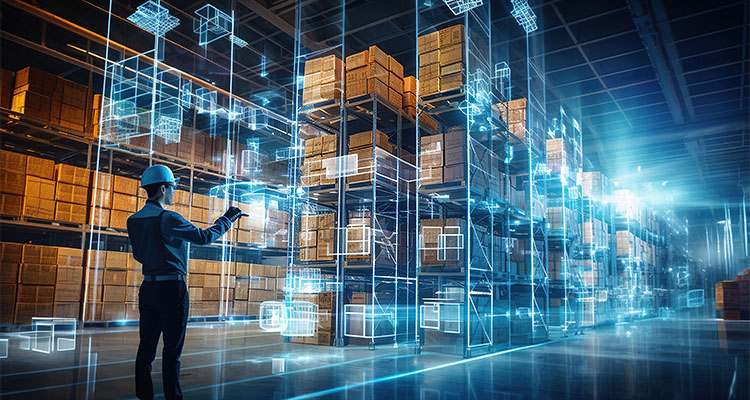
Transforming logistics and meeting supply chain demands
Rapid advancements in robotics technology have sparked a revolution in the logistics industry and the global supply chain, with today’s machines being more intuitive, sophisticated and autonomous. A recent study highlights this development, showing that warehouse automation boosts productivity by 25 percent, improves space utilization by 20 percent and enhances stock use efficiency by 30 percent. As such, it is predicted that around three-quarters of companies plan to implement some form of robotics warehouse automation by 2027.
Beyond logistics, the transformative impact of robotics is also being witnessed across multiple sectors – from logistics to healthcare, to other service industries. As the technology continues to evolve, it raises two critical questions: what does the future hold and what are the key use cases shaping innovation across today’s industries using robotics?

Exploring the future of the robotics industry
One significant trend is the rise of autonomous systems increasingly used in manufacturing, logistics and service industries. These systems leverage advancements in AI and sensor technologies to operate without direct human intervention. Autonomous robots are able to optimize processes while reducing errors and improving efficiency.
For example, manufacturing autonomous mobile robots (AMRs) are being used to handle tasks from transporting materials to product assembly. This is a major change from traditional industrial robots, which have often been stationary and follow pre-programmed instructions. Modern AMRs can navigate dynamic environments using sensors and real-time data allowing them to better work alongside human workers, respond to changes in their environment and adapt to new tasks.
In the warehousing and logistics sector, AMRs are being used to streamline inventory management and gather real-time data from the warehouse for better optimization. With the continued growth of e-commerce, challenges with shipping allocations and capacity, businesses need more accuracy of their inventory to ensure they remain competitive. When looking at these challenges, coupled with shortages in the workforce, the demand for autonomous robots in the logistics industry is expected to surge.
Redefining work through human and robot collaboration
One key trend we have observed in recent years is the advent of robots working safely together with humans. This shift has allowed businesses to improve productivity, while reducing physical strain on employees and improving overall site safety.
 Thanks to the advances made in sensor technologies, cameras and AI, modern AMRs are able to understand their surroundings and work in harmony with human counterparts while robots can also be used to carry out tasks which pose risks to human health.
Thanks to the advances made in sensor technologies, cameras and AI, modern AMRs are able to understand their surroundings and work in harmony with human counterparts while robots can also be used to carry out tasks which pose risks to human health.
One of the major benefits of AMRs today is their flexibility. Traditional industrial robots required space, complex programming and dedicated workspaces, yet AMRs are relatively easy to deploy and can be programmed by non-technical experts. This broadens the appeal of the technology from large enterprises to SMEs that may not have traditionally had the resources to invest in large-scale automation systems. These advances are democratizing automation and allow businesses of all sizes to reap the benefits of robotics.
We can expect to see even more sophisticated forms of human-robot collaboration in the coming years as more businesses have access to the technology and start to see the benefits of it.
The evolution and impact of AI
The integration of AI with robotics is one of the most exciting developments of recent years. This shift has allowed robots to transition from reactive machines to predictive and intelligent systems. AI enables robots to learn from their environments, make decisions and adapt to new situations without human intervention. This shift is driving innovation in a wide range of applications.
AI advancements will make robots more autonomous, intelligent and adaptable to different environments. This will expand the scope of robotics across industries, driving innovation in areas like manufacturing and logistics, while lending to innovations that will help robotics gain a foothold in handling highly personalized tasks. Additionally, where robots and AI come together is in feeding data to analytics platforms. Here, AI technologies can be used for things such as optimizing warehouse layouts, the best picking routes and ensuring goods are not lost in the warehouse.
The journey towards a more resilient supply chain
Looking ahead, the robotics trends highlighted are set to continue transforming supply chains and industries reliant on automation. From autonomous machines and collaborative robots to AI-enhanced solutions and sustainable designs, a new era of automation has begun.
These innovations are poised to improve supply chain efficiency, while helping to combat various industry bottlenecks. As robotics continue to evolve, future machines will become increasingly intelligent, adaptable and capable of complex tasks – empowering human workers to focus on strategic insights. The result will be a more resilient, streamlined and automated supply chain.
Andrei Danescu
Andrei Danescu is CEO and Co-Founder of Dexory. Dexory is revolutionizing the warehousing and logistics industry with AI-driven automation and advanced robotics, delivering real-time data intelligence that elevates operational efficiency. Driven by its purpose, the company leverages autonomous technology to simplify complexity, unlocking valuable data insights that propel businesses to new heights.